Throughout history there have been numerous idioms and adages with the word “instrument” in them, including “playing the lute to a cow” (to fall on deaf ears), “burning zithers and cooking cranes” (to ruin something perfectly wonderful), and “the lute and psaltery are in harmony” (conjugal bliss). The “instrument” referred to in all of these sayings, however, is not any instrument that most contemporary people are familiar with, but actually the guqin — an ancient seven-string Chinese zither. For instrument makers and collectors, each guqin is alive and possesses its own unique personality.
Currently underway, the Museum of World Religions’ exhibit “Chinese Zither throughout the Ages: The Art of the Guqin in Taiwan” has around 30 of the zithers from well-known collectors on display. Wu Wen-li, head of the museum’s media and marketing department, says that nearly all of the guqin on display are new instruments that were made in recent years. Besides introducing guqin-related sayings and explaining how the instrument is made, there is also an area set up that simulates the actual experience of playing the guqin.
With well over a thousand years of recorded history, there is actually a lot of knowledge to take in when learning the guqin, including names, forms, its musical notation, and the entire process of making the instrument. Anatomical terms were used for the names of the various parts of the instrument, including its head, forehead, the nape of the neck, shoulders, waist, tail, feet and gums. There are as many as 100 different types of guqin, which can typically be distinguished by how the curves are designed at the “nape of the neck” and the “waist.”
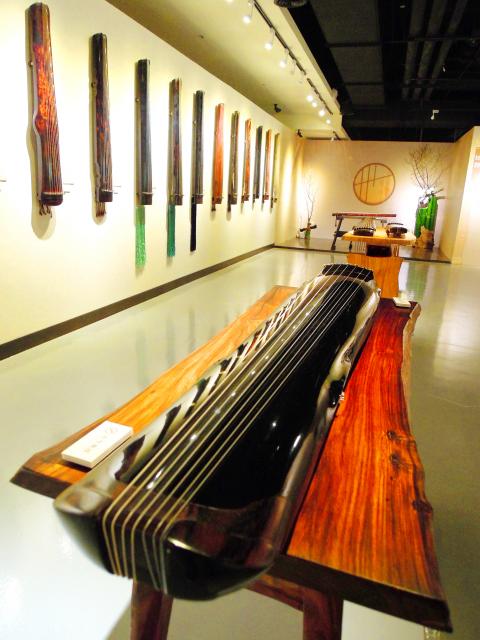
Photo: Huang Pang-ping, Liberty Times
照片:自由時報記者黃邦平
The overall measurements of the instrument have also been standardized over the years. The length of the instrument is supposed to be three chi (0.96m), six cun (1.92cm) and five fen (16mm), signifying the 365 days of the year, while the width is supposed to be six cun, symbolizing the six he (coordinations), or up, down, east, west, south and north. The top of the guqin is arched to represent the heavens, while the bottom is flat, representing the earth, alluding to the belief that “the heavens are round and the earth is square.” The top of the guqin has 13 emblems, which not only represent the notes of the octave, but also symbolize the 12 months of the year, including the largest one in the middle — the seventh emblem — representing the intercalary month on the lunar calendar.
The museum has teamed up with Fu Jen Catholic University’s Department of Religious Studies, Fu Jen’s Tsung Hsuan Guqin Society and the Taiwan Tzung Hsuan Taoist Culture Research Society in organizing the exhibit. But what does the guqin have to do with religion? Wu says that the instrument, aside from being used to play music, has also served a spiritual purpose throughout history, being used to purify the mind and promote good qi in the body, which from a modern perspective gives the instrument a certain religious significance, similar to how yoga and taichi originated from traditional religious practices. The museum’s Web site is http://www.mwr.org.tw. The exhibit will be on display until Jan. 20 next year.
(Liberty Times, Translated by Kyle Jeffcoat)
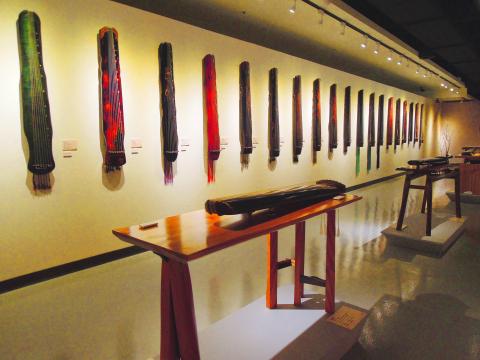
Photo: Huang Pang-ping, Liberty Times
照片:自由時報記者黃邦平
對牛彈琴、焚琴煮鶴、琴瑟和鳴,歷史上有許多與琴有關的成語或典故,多數彈的不是現代人熟悉的樂器,而是古琴,在製琴人與收藏家眼中,每把琴像是有生命一般,具有獨特的性格。
宗教博物館正舉辦「千古琴緣:台灣古琴藝術展」,展出卅多把名家收藏的古琴。媒體行銷部主任吳文禮說,參展的古琴幾乎都是近年製作的新品,展場除了介紹古琴典故、製作流程,也可模擬體驗彈琴。
古琴其實有很多學問,從名稱、形式、樂譜、製作過程,都有千百年保存下來的傳統可依循。例如琴體各部位採取擬人化命名,如琴頭、琴額、琴項、琴肩、琴腰、琴尾、雁足、龍齦等。古琴的形式多達百種,通常差異處在琴項和琴腰的內彎曲度各有不同設計。
琴身的尺寸也有一定,長三尺六寸五分、代表一年三百六十五天,寬六寸象徵六合(上下東西南北);琴面是弧形,代表天,琴底為平,象徵地,也代表天圓地方。琴面上都有十三個「徽」標示音階,也象徵一年十二個月,中間最大的第七徽是閏月。
宗博館這次是與輔仁大學宗教學系、輔大宗玄古琴社及台灣宗玄道學文化研究會合辦展覽,古琴和宗教有什麼關係呢?吳文禮說,古琴代表的不只是音樂,更有淨心正氣這種精神意涵,就現代的眼光,也有宗教的意味,就像瑜伽、太極原本也是宗教修行的產物。宗教博物館網站http://www.mwr.org.tw。展覽至明年一月二十日為止。
(自由時報記者黃邦平)

Picture a 45-foot-long animal with a 5-foot-long skull and 3-foot-long arms. It may not seem strange until you realize that a human with those proportions would be 6 feet tall with 5-inch arms. Although the Tyrannosaurus rex went extinct 65 million years ago, the mystery of its unusual body __1__ has fascinated scientists for over a century. Barnum Brown, the paleontologist who first discovered T. rex fossils, initially found it hard to believe that the tiny arms belonged to such a __2__ creature. One of his colleagues speculated that the short forelimbs might have been used to hold the
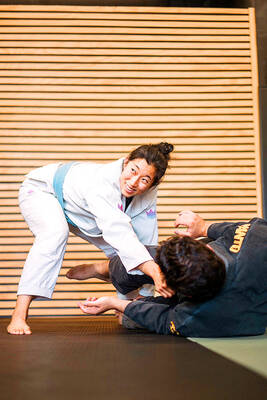
A: Actually, Brazilian jiu-jitsu is particularly good for small people like you. B: Really? How so? A: According to Diana Wang, a US doctor of physical therapy, the BJJ’s purpose is to help smaller, weaker people defend themselves by using various techniques, such as leverage. B: That sounds interesting. What time does Dr Wang’s BJJ seminar begin tonight? A: The event is scheduled for 7:30pm at PMA Brazilian Jiu-jitsu in Taipei. Admission is free, but donations are welcome. A: 其實你的個子比較小,很適合練巴西柔術呢。 B: 真的嗎?為什麼? A: 據美國理療醫師王幼瑞博士說,巴西柔術的概念是讓弱小的人,也能利用槓桿作用等技巧防身。 B: 真有趣,王醫師的巴柔研討會幾點開始? A: 今晚7點半在「台北巴柔運動館」,免費入場自由樂捐唷! (By Eddy Chang, Taipei Times/台北時報張迪)
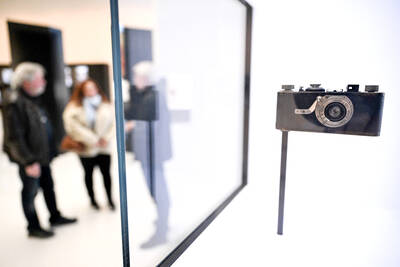
Photographer Franziska Stuenkel likes to take spontaneous urban shots, so she needs a nimble camera that is ready to go when inspiration strikes: her German-made Leica M11. “I have to be very quick and discreet,” said the Berlin-based artist who captures reflections of people walking past windows, their contours merging with the shapes behind the glass. Stuenkel’s compact Leica is the perfect camera for the job, the 51-year-old told AFP. Famous for its pocket-sized and retro-style devices, the Leica brand is celebrating a milestone as it marks 100 years since its first commercial camera was presented to the public. The
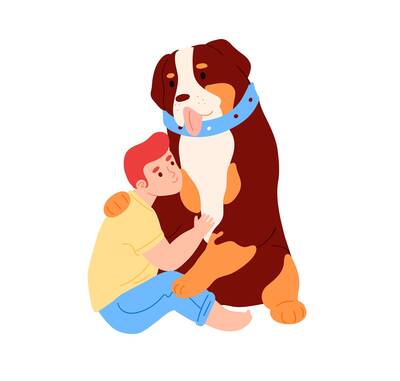
Dogs’ noses are incredibly keen. They can even detect changes in cortisol levels in human sweat and breath. Known as the “stress hormone,” cortisol increases when humans are under pressure. Recent research indicates that the smell of human stress can influence a dog’s behavior and emotions. In the study, human volunteers were exposed to the stressful tasks of preparing and delivering a speech on the spot and then solving math problems. __1__ Researchers collected sweat and breath samples from the volunteers on pieces of cloth during both their stressful and restful states. Meanwhile, other researchers worked with 18